GRINDHOUSE MINI REVIEWS
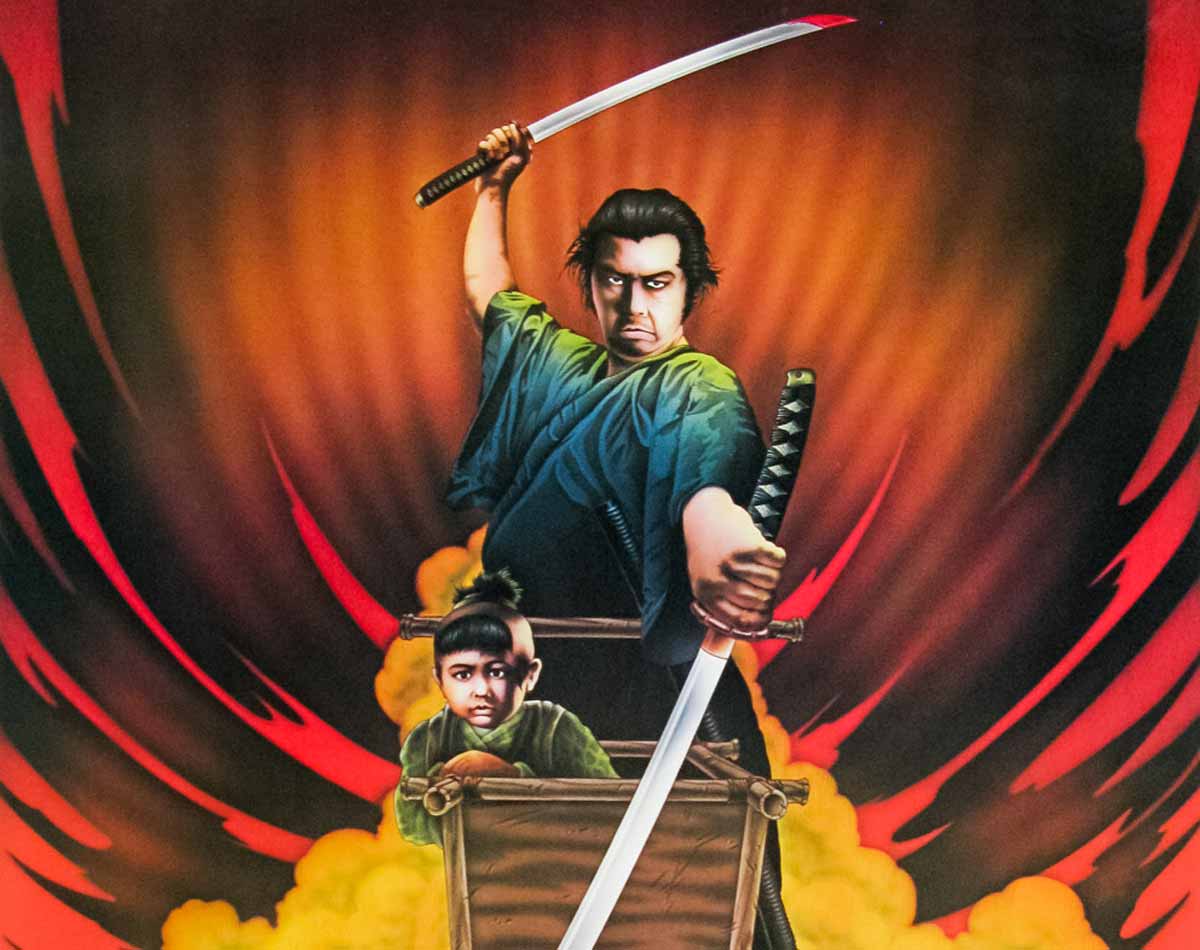
SHOGUN ASSASSIN (1980)
Dir: Kenji Misumi (and Robert Houston, American version)
In the last week of September 1973 I saw at The Toho La Brea something called The Sword of Vengeance – Part 4, Baby Cart in Peril on a Japanese language double-bill (all prompted by a promising LA Times review by Kevin Thomas). The hero of this blood-soaked popular Japanese series, stoic, semi-mad father Ogami Ittō aka ‘Lone Wolf’ (Tomisaburô Wakayama), practically had my movie-going companion diving under the seats, as Ogami Ittō’s samurai sword turned hundreds into limbless, throbbing, artery-spurting corpses (I gave the clever carnage a B+).
I wondered how long, considering how popular Hong Kong Kung Fu crap was, it would take for an American distributor to bring Lone Wolf and his Baby cart from hell to a grindhouse or drive-in near you.
Columbia Pictures was the first out of the gate, when they took Sword of Vengeance – Part 3, Baby Cart to Hades, and released it as Lightning Swords of Death. But then seven years later, here comes the now Corman-less New World Pictures, Shogun Assassin. But remember, until recently, the MPAA had been slapping bloody Japanese flicks with X ratings for violence (the fate of New Line Cinema’s superior Sonny Chiba starrer The Streetfighter). That this crimson red showstopper, where people shower the landscape with red hemoglobin as if they had garden hoses for veins, managed only a R rating, shows cooler heads prevailing at the ever more reasonable MPAA.
Now, tricked up with extremely impressive English language dubbing, and a new buzzy electronic score by none other than Mark Lindsay (former lead singer for those top 40 bubblegum goofballs Paul Revere and The Raiders), to deliver a bloody good time to unsuspecting patrons. A small section of the first film (Sword of Vengeance, the origin part), and most of the second entry (Baby Cart at the River Styx) has been stitched together to provide American audiences with Shogun Assassin.
The story is simplicity itself. A young toddler (The Lone Wolf’s infant son, Daigoro played by Akihiro Tomikawa) recalls, via voice-over narration, his ma’s death at the hands of the evil shogun’s minions (dad used to be wicked Shogun’s head head-chopper) – and Dad’s eternal Vengeance as one deadly foe after another comes looking for the undefeatable, vaguely demonic, Ogami Ittō (though, like Eastwood in Josey Wales, he basically wants to be left alone). The fact that little Daigoro narrates the adventure, changes the story somewhat from its original Japanese origin. As David Chute pointed out in his review for The LA Herald Examiner, in the Japanese flicks, despite six films in the series, the kid never ever says a word. Chute claims this robs the little brat of his wordless demonic quality. Well, maybe it does. But his narration is pretty well-written, and it goes along way to starting the film off in a classy manor.
Among the dozen or more comic book styled villains that come looking for killer and son, include a group of Ninja assassin women, the Shogun’s son, and a deadly trio that call themselves The Three Masters of Death (they kill via claw, club, and mailed fist), as well as countless others. Highlights include, jugular spray, hacked off flying limbs, faces are bisected vertically, and from behind we see a head split in half like a Yubari melon. In a particularly gruesome section we see the killer women hack a man to literal pieces, and the Death Trio kill a small army as way of introduction to the audience. As fans of the series are already hip to, the kiddies baby cart is also packed with anti-personnel cutting accoutrements. The deliciously stylish Kenji Misumi direction and Chriski Makiura’s wide-screen Metrocolor lensing pop the eyes. This American coat of paint that New World added to the Japanese original, is well done and depending which one you see first, could be considered an improvement. But in a really cheeky move, that screams disrespect, original director Kenji Misumi is removed from the directorial credit replaced by some bozo named Robert Houston. The sullen Ogami Ittō and his small fry sidekick were taken to heart by the hooting it up Hollywood action crowd.
(Original Baby Cart at the River Styx version, A-. Yankee meddled version Shogun Assassin, B+).
– Jim Sheldon and Quentin Tarantino –
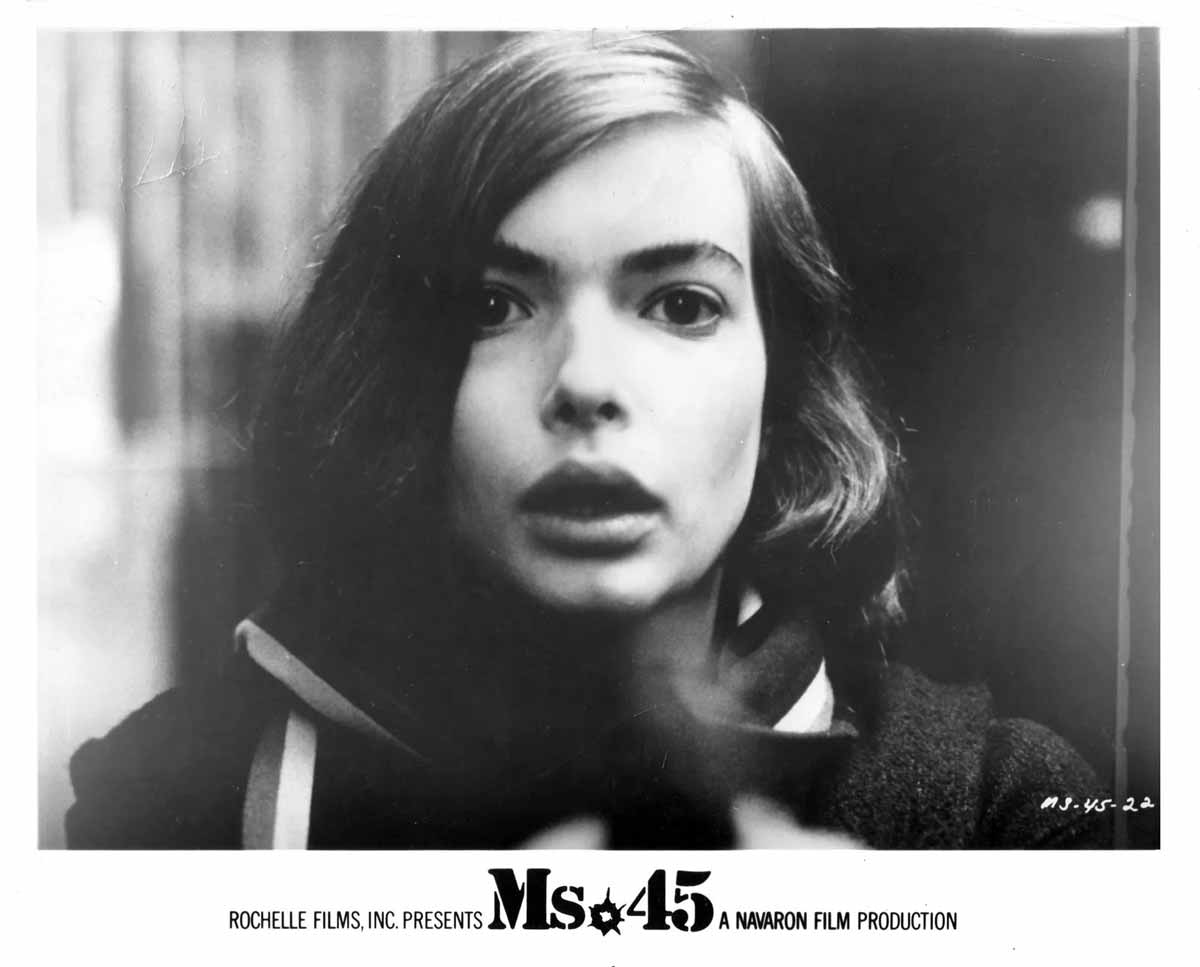
MS. 45 (1981)
Dir: Abel Ferrara
Ms.45, despite an ad campaign that suggests a distaff Death Wish, is actually a reasonably competent, but hopelessly nihilistic, urban nightmare about a young woman driven bonkers after enduring two separate rapes in one day.
Mute Manhattan garment district worker Thana (Zoë Tamerlis, giving the best lead performance in an exploitation film of that year), who works for seemingly-gay but probably bi-lecherous Albert Sinkys, is yanked into an alley on her way home from the grocer, and is bent over a garbage can and fucked up the ass at gunpoint by masked booty bandit Jimmy Laine (really, director Abel Ferrara). Then, once home, she’s confronted by armed burglar Peter Yellen, who proceeds to rape her more conventionally. She manages to bludgeon him to death with a paperweight and an iron, cut up his bod into separate pieces in her bathtub (minimal gore, the fact she keeps him clothed, including his black leather jacket, accounts for some of the effective black comedy pertaining to the disposal of his body), refrigerate the disembodied limbs, for later dispersal all over town in various New York trash cans (a shrieking bum will find a hand, the authorities will find the head). After hallucinations and an at-work bit of delayed-reaction hysteria – watch out men!
A New York street trash goofball gets blasted by Zoë in an alley for returning her bag (the gun belongs to the first rapist, and magically never runs out of bullets). Steve Singer, a Looking for Mr. Goodbar-type, gets shot inside his pussy pad (the biggest splatter belongs to him). Talky-depressed bar patron Jack Thibeau, shares with her a one-sided heart-to-heart talk (in a funny bit, he tells his tale of romantic disappointment to Zoë, so self-obsessed, he never realizes she’s mute), which leads to a confusing suicide (?) of Thibeau.
Then Zoë, Bronson-style, switches to a seductive whore-like persona and goes looking for male victims to shoot full of holes. Including a whore-beating black pimp, a cruising Arab sheik and his chauffeur, and a number of encircling gang members in Central Park (by the time she’s facing down an entire gang, like Eastwood in a spaghetti western, the film has become officially ludicrous, but also, despite the ugliness of the set-up, a groovy gas). After recent cinematic depictions (“The Exterminator”, “Wolfen”, “Escape from New York”, “Night of the Juggler”, “Fort Apache: The Bronx”) if Thana dropped an atomic bomb on the big apple, she would seem justified. And at first, we root for Zoë to blast every son-of-a-bitch she comes across, whether they deserve it or not. But then we watch her narrowly miss out on plugging an innocent Chinese lad, we realize that Thana has gone full Deneuve in “Repulsion”.
All leading to a climatic .45 Caliber massacre at the Halloween office party (Thana dresses in a nun’s habit, and in a nice touch, she kiss blesses the bullets she loads for her final kill). Director Abel Ferrara and screenwriter Nicholas St. John certainly don’t like to linger (at 74 minutes, the film’s ten minutes shorter than when reviewed by Variety in April). James Momel’s nighttime NYC photography impresses, and Joe Delia’s tortured-sax score annoys, but stays in your head. In a few years time, this could prove a popular cult film. As well as an impressive calling card for both director Ferrara and mesmerizing star Tamerlis.
Like a beautiful flower growing out of a rat’s ass (B+).
– Quentin Tarantino & James Sheldon –
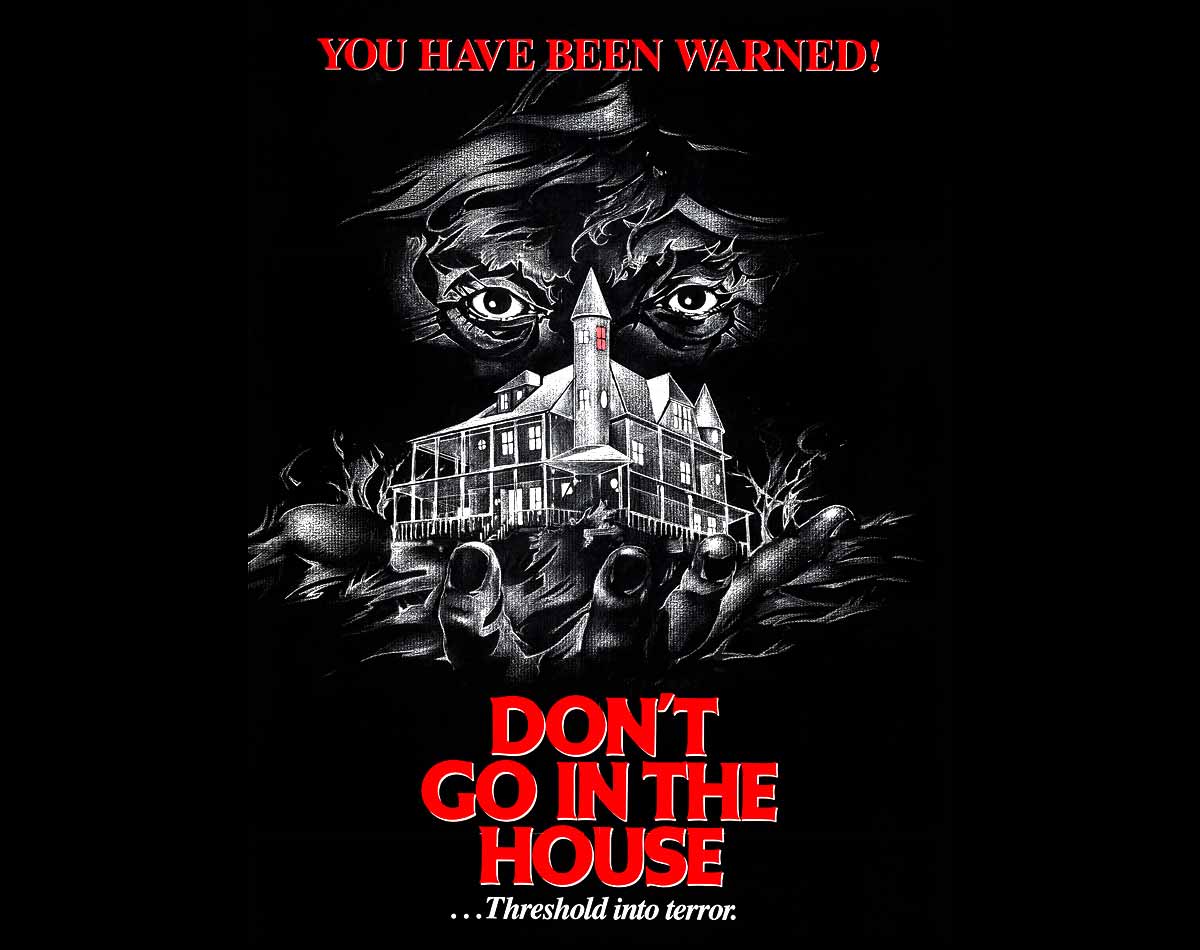
DON’T GO IN THE HOUSE (1980)
Dir: Joseph Ellison
(Film Ventures Int.) I hardly know how to react to “Don’t Go In The House”, one of the sicker contemporary – psycho – horror films to come down the pike in years. It is a virtual instruction manual for the closet maniac, yet the film subtly shows the carry-over effect of child abuse from generation to generation (or, if not to off-spring, to innocent victims of nuts).
This 1979 drama, without any intentional or unintentional humor (always a relief), still recalls the spirit of the old EC Comics, aided by gloomy New Jersey and New Rochelle (NY) locations, Oliver Wood’s dim lensing, and most of all writer-director Joseph Ellison’s view of humanity. Moreover, the film seems virtually anti-Catholic, yet is a casebook study in Catholic guilt.
In short, I kinda liked it, but still gave it my highest rating for total trash.
A convincing Dan Grimaldi is a garbage-incinerator stoker who looks on in attraction/repulsion when a co-worker almost burns to death when an aerosol can explodes. Co-worker Robert Osth, who likes the possibly – gay Grimaldi, becomes suspicious. Mother dominated, voices-hearing Grimaldi goes home to find ma dead; he’s first horrified, then exultant (he can now play his rock records loud), then sublimated – vengeful (ma used to char his forearms over gas flames when he was misbehaving as a small tyke). A series of three women become victims of his misplaced anger, with the m.o. shown only on the first, sexy florist Ruth Dardick. She’s given a ride, Grimaldi says he has to drop something off at home first; she’s then knocked out, stripped totally nude, tied at the wrists, and suspended from a ceiling chain in a metal-lined room – and then Grimaldi, in surplus fire-fighting hood and togs and carrying a flamethrower, chars her on-camera (excellent trick lensing). All three victims are then dressed in ma’s clothes, and even slapped around, but then Grimaldi starts to have horrifying visions (especially in a beach setting) wherein the barbecued babes, and even his ma (who has been slowly charred off-screen as she lay dead in her chair), lurch at the poor fellow. Disguised confession with understandably bewildered priest Ralph D. Bowman is of little avail.
Ahead lie a double-date with Osth (who’s married, but cheating) that turns into a disco nightmare, with a set-on-fire lass who made the mistake of duplicating ma’s arm pull gesture, a beating of Grimaldi by the lass’ tough brother, and flight home. Osth and Bowman beat the brother to Grimaldi’s home, but Grimaldi has picked up two distaff hitchhikers along the way. Before the final credits, it will be Hell-on-Earth for two more cast members, with a supernatural (or mental breakdown) final twist and another boy kicker.
Joseph Ellison (who co-wrote with producer Ellen Hammill and original story writer Joseph R. Masefield) gets flawless performances from all, including whoever played the gay-but-not-pushy men’s store salesman. Richard Einhorn’s music includes some almost incongruous disco stuff. Attractively repulsive. (D+)
– James Sheldon –
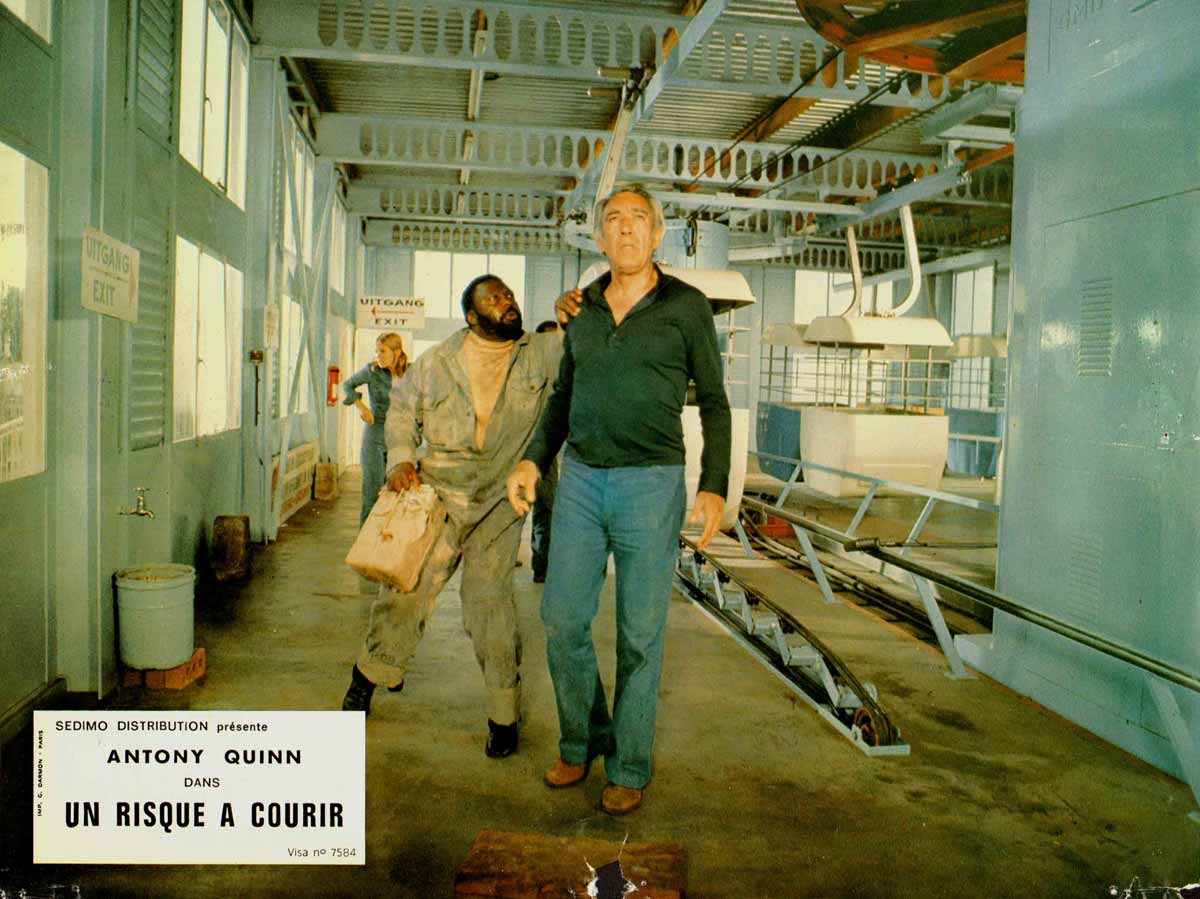
TARGET OF AN ASSASSIN (1977)
Dir: Peter Collinson
(PRO Inti.) “Target For An Assassin” is really 1977’s “Tigers Don’t Cry”, a South African film that showed up as the CBS Wednesday Late Night Movie on January 7th of 1981 as “Long Shot”. But the original film showed up for a half week booking on January 22 as one-quarter bill at the exhuming public toilet in Downtown LA known as The Cameo (I never saw the TV edited version, but all that would have to go are a few “goddamns”, a couple of “Christ’s”, and an “ass” or two).
This drama of a surprise angle kidnapping of a black African leader, is notable only for starring Anthony Quinn, box office poison (“The Greek Tycoon” “The Children of Sanchez”), and being directed by recently dead Peter Collinson, a British filmmaker with a flair for sleaze (“The Penthouse”, “Open Season”, and the upcoming more wholesome looking “The Earthling” with William Holden and Ricky Schroder). Otherwise it’s a muddled miler, bad acting, lousy sound and phony interracial brotherhood.
Black Simon (“Zulu Dawn”, as the Zulu leader) Sabela, president of ‘Gamba’ is wounded in Johannesburg in a kill-try by high perched hit man John Phillip Law (“Tarzan, The Ape Man”), latterly revealed as being in the employ of Sabela’s own devious aides, headed by South African film mainstay Ken Gampu (sorta the Woody Strode of South Africa). Hospitalized Sabela is then drugged and nabbed by male nurse Anthony Quinn, a lifelong failure seizing an opportunity. Quinn and Sabela, natch, form an uneasy, even semi-collaborative partnership as Law (after a hospital try) seeks to complete his assignment. Marius Weyers is the cop on the case, and one very untalented Janet Du Plessis is Quinn’s wimpy, clingy, clench teethed, teary, blonde blue-eyed grown daughter who unwillingly gets caught up in the chase (Weyers has 48 hours before the abduction goes public). The pursuit leads to an abandoned amusement park, a fatal Quinn set brush fire at a pickup point, a stalled and later falling cable car, multi-copter swoop, Sabela’s announced pardon of Quinn’s actions (despite Sabela’s being a visiting dignitary in South Africa), and Quinn’s eventually fatal gunshot wound (Law is blown off of a cliff by a pissed off, fired upon copter pilot). Sabela’s accented speech is discernible maybe 40% of the time. Quinn adopts angst poses. Du Plessis should have died, the sound quality is of work print level at best. Scot
Finch’s script is riddled with pop sociology, phony camaraderie and – for an apartheid country – amusing black audience and character condescension.
Brian Probyn’s lensing is still unfaded. The 95 minute PG rated print is and was instant TV fodder, all bloodletting is off screen.
A flimsy (F).
– James Sheldon –
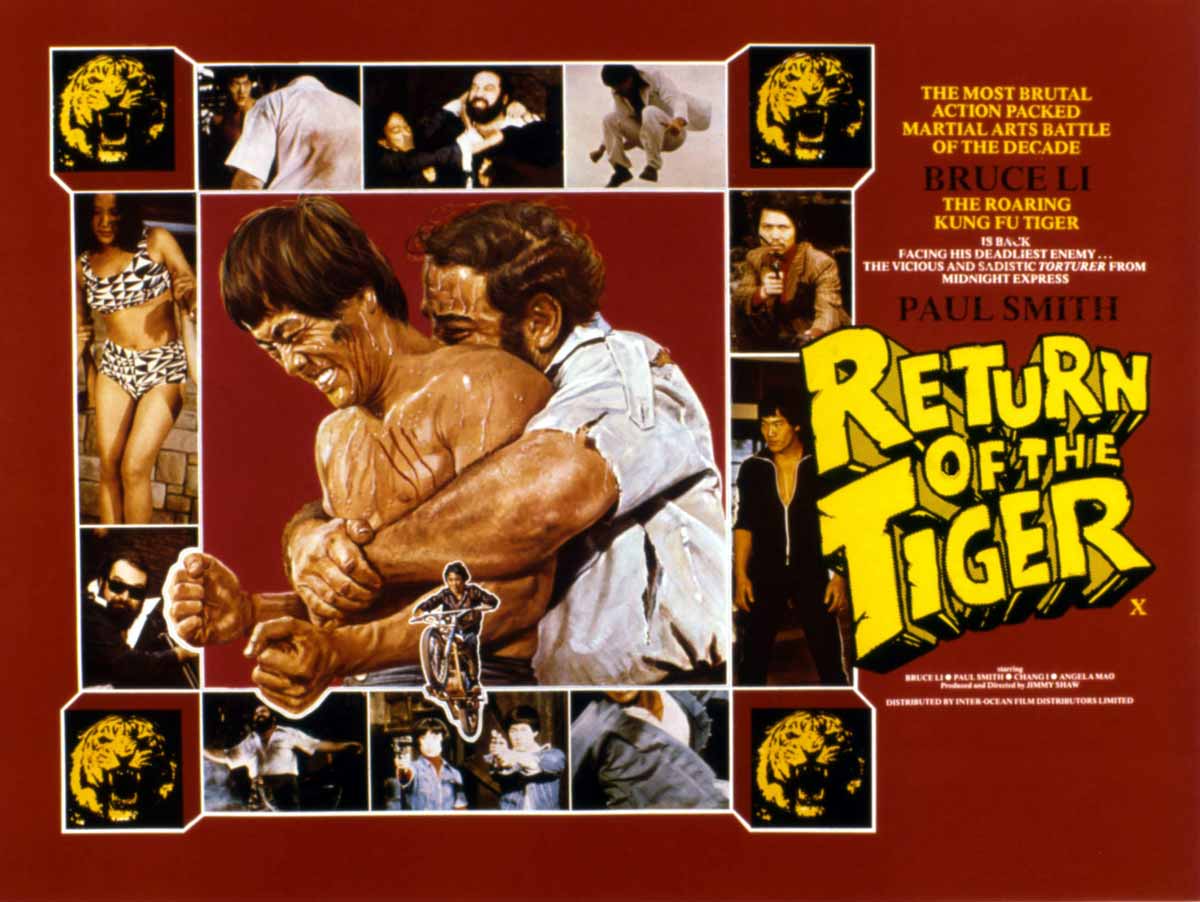
RETURN OF THE TIGER
Dir: Lee Tso Nam (Jimmy Shaw)
(21st Century Distribution) Despite having the same lead actor (Bruce Li), and director (Lee Tso Nam, under his Jimmy Shaw pseudonym), and many of the same cast members, Return of the Tiger isn’t a sequel to Bruce Li’s earlier Los Angeles hit with the ebony-kung fu loving crowd, Dimension Pictures’ Exit the Dragon, Enter the Tiger. But trash flick distributor 21st Century Distribution sure wants you to think it is. Hence the sound alike name, though the story and characters are different, and there’s nobody in the flick named Tiger!
Return of the Tiger stars Bruce Li (one of cinema’s snazziest dressers this side of Burt Reynolds and Richard Roundtree) as a finally revealed cop who is out to bring down the round western mob boss Mr. Paul (aka The Big Westerner) played by flown-in western actor Paul L. Smith (the torturer from Midnight Express, and the then upcoming Altman film Popeye as Bluto). Smith’s Mr. Paul brings to mind in both look and persona Marvel comics The Kingpin in The Daredevil comic books. Bruce Li poses as a hit man to get in with Smith’s criminal organization. In this effort he’s joined by none other than queen of the seventies female fight superstars – the Deadly China Doll herself – Angela Mao (here billed in the opening credits under her real name, Mao Ying) and coming out of retirement apparently to play this routine Special Guest Star role. Martial Arts legend and mainstay Chang Yi (here billed as Chang I.) shows up as well in a nothing part.
Li, who has genuine star charisma (maybe even more than his namesake Lee) is annoyingly absent for a good portion of the action, as supporting actors and subplots abound, and random action (some of it quite well-staged) that has nothing to do with the plot, keeps overtaking the movie for stretches at a time – i.e. in the form of karate school fights (students we don’t know fight other students we don’t know for ten minutes). More than one scene plays in the movie only to abruptly be cut off before its conclusion, leaving the audience screaming, What happened?
The film has a large roster of familiar Hong Kong cinema faces (all of them in Exit the Dragon, Enter the Tiger) playing minor villains, Fu-Hsiung Cheng plays his usual part of a giant, fat, dim-witted minion of Mr. Paul’s named Fat Tom (though with more screen time than usual), some twin bodyguards, a cool daddy-o named Mr. Wong (Hsing Hsieh, who comes across as a Jack Palance type), the leaders of the rival smack dealers (Han Hsieh and Fei Lung), and Fei Wang plays his stock role of nervous traitor Yu Ching. But the actors playing the heroes – Bruce Li and Angela Mao – seem to be working part time, as if all the big names on this production made it concurrently with another project they obviously cared more about. But while it’s frustrating that we don’t see more of the main characters (Li, Mao, Smith, and Chang), this allows the minions of the various camps much more screen time. And some of these scenes featuring the minions are the film’s most memorable, especially Fei Wang’s betrayal by Bolo Yeung and his other colleagues. This emphasis on the role of the individual minions in this crime story, even if it’s more by necessity than desire, lends this whole gangster saga a nuance similar tales don’t possess. But even the film’s unique rhythm inside of its choppy editing structure (the English language print seems to strive esthetically for the flow of a choppy, spliced to shit, drive-in 35mm garbage film print), can’t set you up properly for the film’s spectacular climax.
Nobody does climatic fight to the death battle royals like ‘The Master Blaster’ Lee Tso Nam.
But The Master Blaster never did one like this before.
Up to the film’s climatic Kung Fu battle, Paul L. Smith’s performance as Mr. Paul is amusingly awkward. Like most white actors from other countries that appear in Hong Kong films, he appears completely bewildered by their way of movie making. He spends the whole movie glowering behind a thick bushy black beard, usually behind giant square plastic sunglasses, or blinking nervously minus the sunglasses, holding a cigar in his puffy sausage fingers, wearing a collection of John Travolta inspired black and white leisure suits similar to the one from Saturday Night Fever, shyly barking out orders in a thin South African accent obviously dubbed by another. Most of the film he seems way over his head. And you resent that Chang Yi, who returns from Exit the Dragon, Enter the Tiger, where he practically stole the show as that film’s main baddie The Baron, is reduced to playing Smith’s right-hand man/lackey. However, once Lee Tso Nam brings the entire ridiculously large cast of villains and henchmen together, some we even know by name (Hi Tom! Hi Mr. Wong!), and then rings the bell that sets them killing each other in a last man standing bloody murder Battle Royal, the film captures that same comic book Jack Kirby essence that Wang Yu’s climaxes achieve, only – if such a thing is possible – more so.
And the “more so” part all has to do with Paul Smith and how The Master Blaster uses him in the final fight. The whole movie has been heading for this fight. While the film up to now has been an entertaining but choppy experience, the idea of a Bruce Li vs Paul Smith gigantic battle has been enticing. Probably more than anything else, because since Paul Smith isn’t a martial artist, they’re going to be forced to stage and choreograph it differently. Probably, concentrate on Smith’s (like The Kingpin and like Bluto) superhuman strength, but since that strength hadn’t been demonstrated all movie long, nobody knew what to expect. Nor did we know would Smith be able to pull off the choreography, and if we had to judge by his performance in the film thus far, the answer would appear to be no. But then the fight starts, and Smith’s Mr. Paul starts tearing guys apart, not like a master in a Kung Fu film, but like a kaiju in a Ishiro Honda Japanese monster movie, or like Jack Kirby’s The Thing in one of his Marvel Team-Up donnybrooks.
Which in retrospect shouldn’t be so surprising. For years Smith was one half of a team in Italian flicks called (Michael) Coby and (Paul) Smith, which were to (Terrence) Hill and (Bud) Spencer, what (Duke) Mitchell and (Sammy) Petrillo were to (Dean) Martin and (Jerry) Lewis, with even one of their terrible rip-off acrobatic comedy action films, getting a stateside release under the misleading redneck-Reynolds sounding title Convoy Buddies. And like those Hill and Spencer shot-in-Miami monstrosities, these Colby and Smith films were basically fight films, just done in that acrobatic comedic style that all Italian action films ultimately succumbed to. So Paul Smith – as a Bud Spencer impersonator – was actually already a fight star. And the main reason that Smith ends up stealing the movie is due to the aplomb he demonstrates executing Lee Tso Nam’s choreography. Which means he fights in the climax like a superhuman strength Bud Spencer, again, which makes him slightly resemble The Thing. This climax was theirs to fuck up. And they not only don’t fuck it up, they deliver one of the most enjoyable last ten minutes to any feature I saw that year.
Rhythm Heritage’s Theme from S.W.A.T. is sliced and diced into the opening credit music and a cover of Nowhere to Run To from The Warriors has a scene cleverly cut to it.
Despite or because of choppy print presentation, a brisk 88 minutes. An enjoyable (C)
Postscript: More than anything else, the thing that Return of the Tiger is most known for now, is how it so thoroughly bested Robert Altman’s Popeye that was released only one month later, and featured Smith as Popeye’s classic antagonist Bluto. Part of the prerelease publicity surrounding Altman’s Popeye was that the climax would contain one of the greatest cinematic fights of all time. Truly absurd for anyone who has sat through Altman’s awful atrocity on the memory of Segar’s sailor man creation. Even though every cartoon knew to end with a big Popeye vs Bluto fight, where Popeye wins due to eating his spinach, Altman perversely denies the audience this cathartic climax. Apparently, Altman’s fumbling of Popeye’s final act was the bridge too far on his genre nose-thumbing Hollywood studio filmmaking career. Popeye was a joint venture of both Disney and Paramount, so when Altman fucked the audience on that picture, he fucked Disney and Paramount both. It didn’t matter that the film did well. They so hated what Altman delivered to them, which was so different from both what they wanted and what he promised to make, that studios refused to hire him for the next two decades. Altman, like Goddard, doesn’t want to just upturn expectations, he wants to cynically piss on them (just to be a fucker, Altman’s Popeye doesn’t even like spinach. What?). However, The Master Blaster’s final Destroy All Monsters meets The Thing Marvel Team-Up with Shang Chi battle of Return of the Tiger delivers where Pot Head-Altman disappoints.
And on the same bill at The Carson Twin Cinema (as well as all over town)
– Quentin Tarantino –
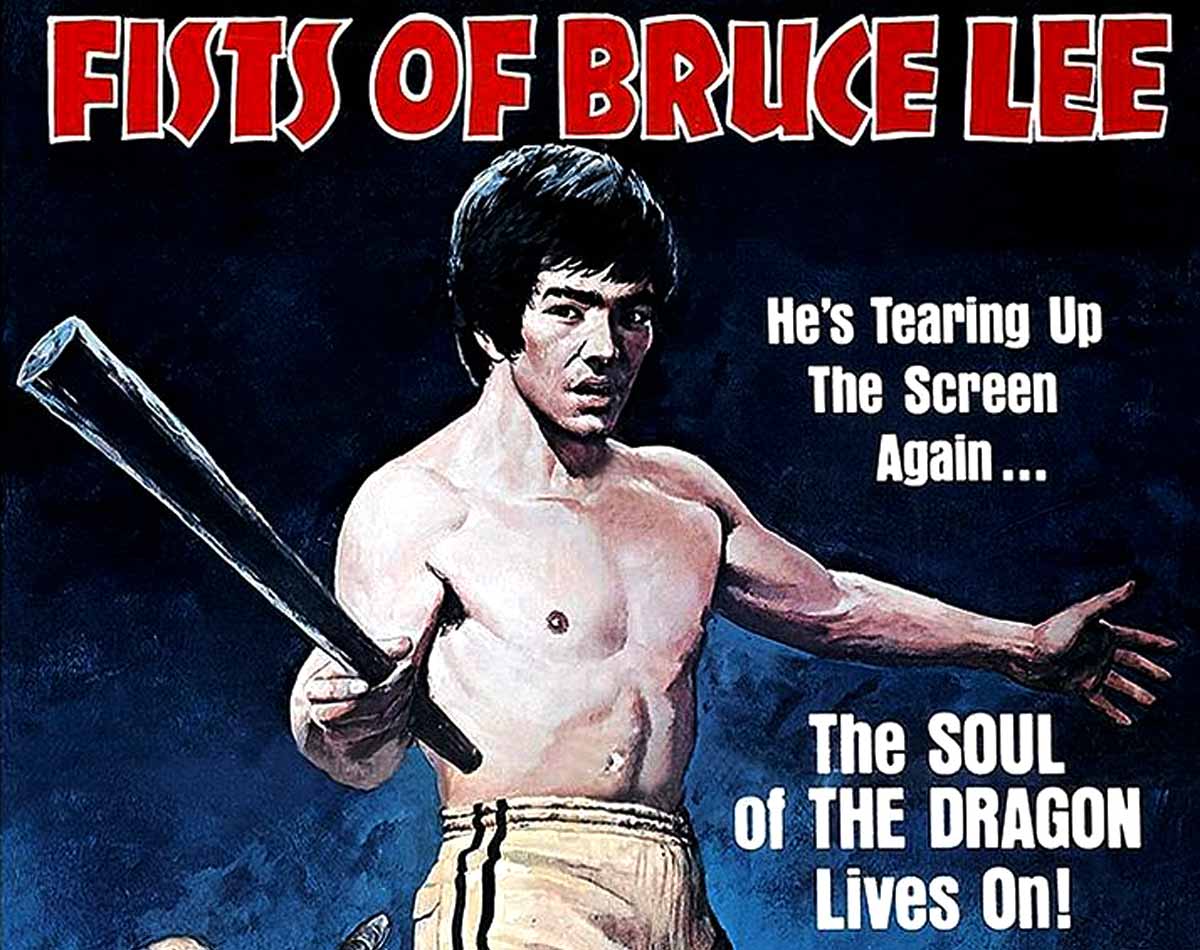
FISTS OF BRUCE LEE (1978)
Dir: Bruce Li (Ho Chung Tao)
(Cinema Shares Int) Fists of Bruce Lee is a lighter toned 1978 item, with Bruce (director as well) Li (eventually revealed, again, as an Interpol agent) posing as an electronic surveillance expert, who’s given access to a reclusive gangster’s estate in order to install a security system. Like Return of the Tiger, two different gangs with an army of minions, played by a large cast of familiar Hong Kong film faces, take up almost half of the running time. Including one blonde surfer Californian in tight white pants that’s pretty memorable (as opposed to Lo Leigh, who in this film is completely forgettable). During Li’s snooping, a bit of a romantic relationship develops between the reclusive mobster’s feisty daughter (Mei-Ling Lin) and Bruce. The reclusive mobster has a fey, nervous, sweaty lawyer, who seemed to base his performance on Rod Steiger’s similar in persona turn as Mr. Joyboy in Tony Richardson’s The Loved One. And like Mr. Joyboy had a romantic obsession with Miss Thanatogenous, so does the mobster’s lawyer have with the mobster’s daughter. So his reaction when he sees Lin and Li making out brought down the house at The Carson Twin Cinema (the only time during the silent show I realized I wasn’t alone). Which in turn leads to an unsuccessful and pathetic rape attempt by the lawyer (no nudity, and no reason for an R rating). I’m not sure why Bruce Li wanted to star in this movie, no less direct the fucking thing. But the carelessness in the fashioning of the English language version is really bottom of the barrel. Especially, all the terrible non actors dubbing the Hong Kong performers into English. With the geeky goon dubbing Bruce Li absolutely the worst.
The choppy print was 91 monotonous minutes.
On the plus side, the film has cleverly and memorably placed needle-drops. A very effective use of Lalo Shiffrin’s score from Enter the Dragon, that dare I say is used more effectively than the Clouse original, the instrumental section of the Live and Let Die Theme, and talk about your funky seventies scores, the film’s opening and closing theme is a cover of Average White Band’s Pick Up The Pieces.
The music alone rises it to an (D-).
– Quentin Tarantino –
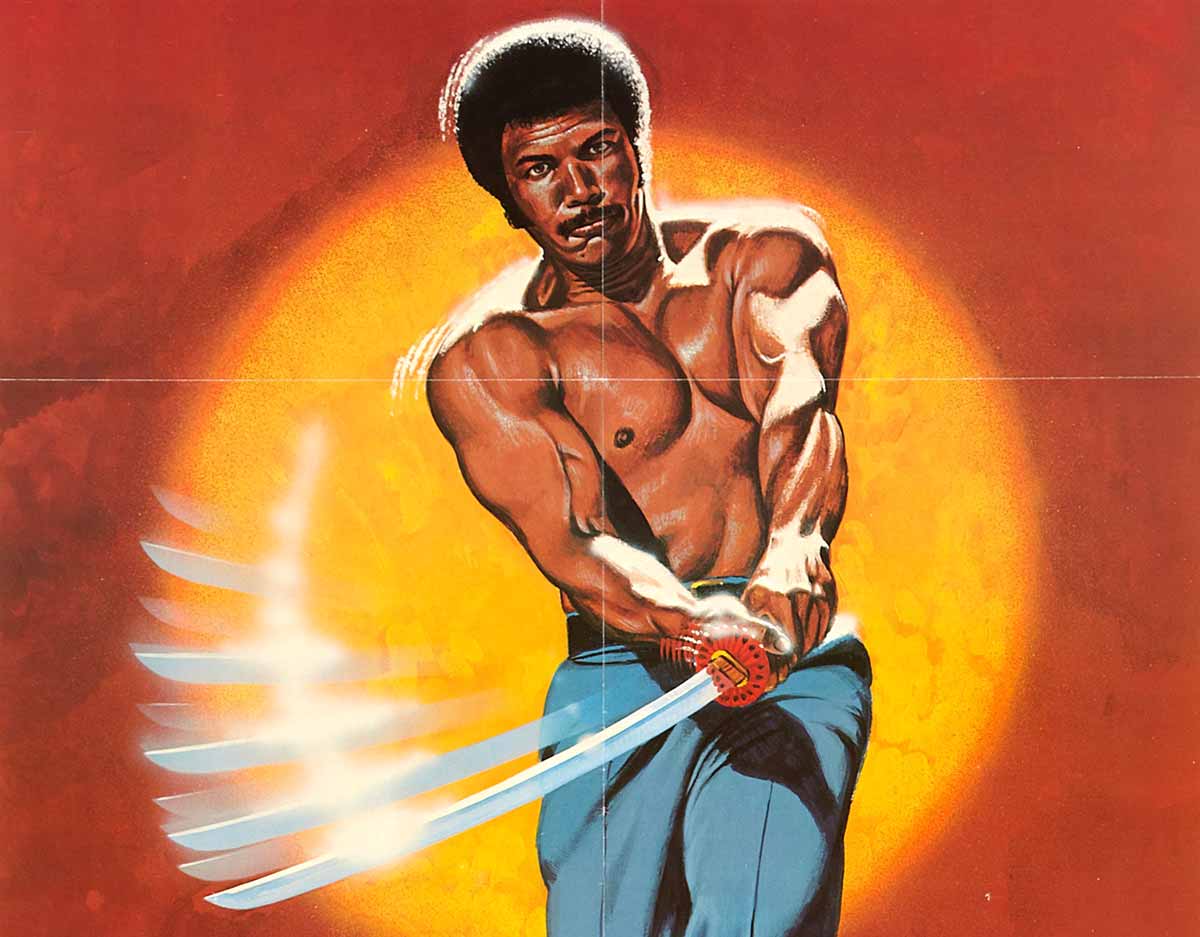
DEATH FORCE (1978)
Dir: Cirio H. Santiago
(Caprican Three) Death Force re-unites genial, beefy black third-string action star James (Angels, Hard As They Come) Iglehart and producer-director Cirio H. Santiago (they both did 1973’s Savage! and 1974’s Bamboo Gods and Iron Men together) in a unique blend of a Filipino blaxploitation/revengeamatic and a samurai slice-em-up, filmed around 1976 in the Philippines and Los Angeles.
Three Vietnam veterans, Iglehart, Leon Isaac (Kennedy, later of Penitentiary 1,2,& 3 and the surprisingly entertaining Body and Soul remake for Cannon Pictures), and Carmen (The Hot Box) Argenziano (now bald, but still loud and snarling), in South East Asia, have become black market gold smugglers (they sell their gold to Filipino trash flick mainstay Vic Diaz). As the smugglers escape the law by boat, Isaac and Argenziano decide that splitting their ill-gotten gains two ways is much more preferable than three. So they slash Iglehart’s throat and chest and dump him in the sea. He miraculously washes ashore on a deserted island where two Japanese soldiers, who still think World War 2 is going on, nurse him back to health. The two, an officer speaking rudimentary English (Joe Mari Avellana) and the other a jealous flunky (Joonee Gamboa), have killed all previous strays to the isle, but Avellana’s senior soldier shows Inglehart the tricks of the bushido blade trade, and a very engaging relationship develops between the two men (Avellana, Santiago’s regular production designer – despite a horrendous old-age make up job – delivers a sensational performance).
Interspersed with these training scenes, back in LA, Isaac and Argenziano start climbing to the top of the Los Angeles gangster pyramid, by wiping out all competition (including one victim blasted outside Hollywood’s World Theatre, where I first saw the film!). On his own, Isaac menaces Iglehart’s wife, Jayne (The Muthers) Kennedy, who he wants for his own (in real life Isaac was Kennedy’s husband, and her son is played by Iglehart’s real-life lumpy infant). The duplicitous gangster tells Kennedy that her husband is dead. Then black balls her from getting work as a bar singer unless she becomes his woman (the reason she can’t land a singing job is supposed to be due to Isaac’s interference, but it also might be because the stunning Kennedy can’t sing a lick).
Meanwhile, back on the island, rescue comes, but the senior Japanese officer, despondent over the accidental death of his aide, after killing a few rescuers, chooses harakiri (you’ll feel sorry to see him go). Now rescued from the island, and armed with his samurai sword, as well as his new-found samurai-skills, Inglehart hits LA, slashing his way – vengeance style – through his former partners’ crime organization, including cutting off Argenziano’s head and sending it to Isaac in a box (the blade-swinging choreography is quite good). Kennedy, who thought her husband was dead, is reunited with Iglehart in a cool scene I swiped for Django and Broomhilda’s reunion (“It’s me, baby”). But then Kennedy, her son and his wife’s roomie are all kidnapped by Isaac to Mexico. Up until now, the film has been rather PG-worthy, but the last couple of reels bring in some delicious, near-X-worthy decapitations (several Isaac minions), and a crowd-cheering bushido blade disembowelment death for the reprehensible Isaac. Jaime Mendoza-Nava helmed the music (including one too many plays of that MOR stand-by, “Whispering Your Name”).
The 97 minutes allow time for more characterization than is usual in these things, and Iglehart (as per usual) makes a solid, macho, empathetic blaxploitation lead. The supporting cast includes Robert Gonzales and Armando Federico.
Filipino trash – with a touch of class. (B-).
– Quentin Tarantino and Jim Sheldon –
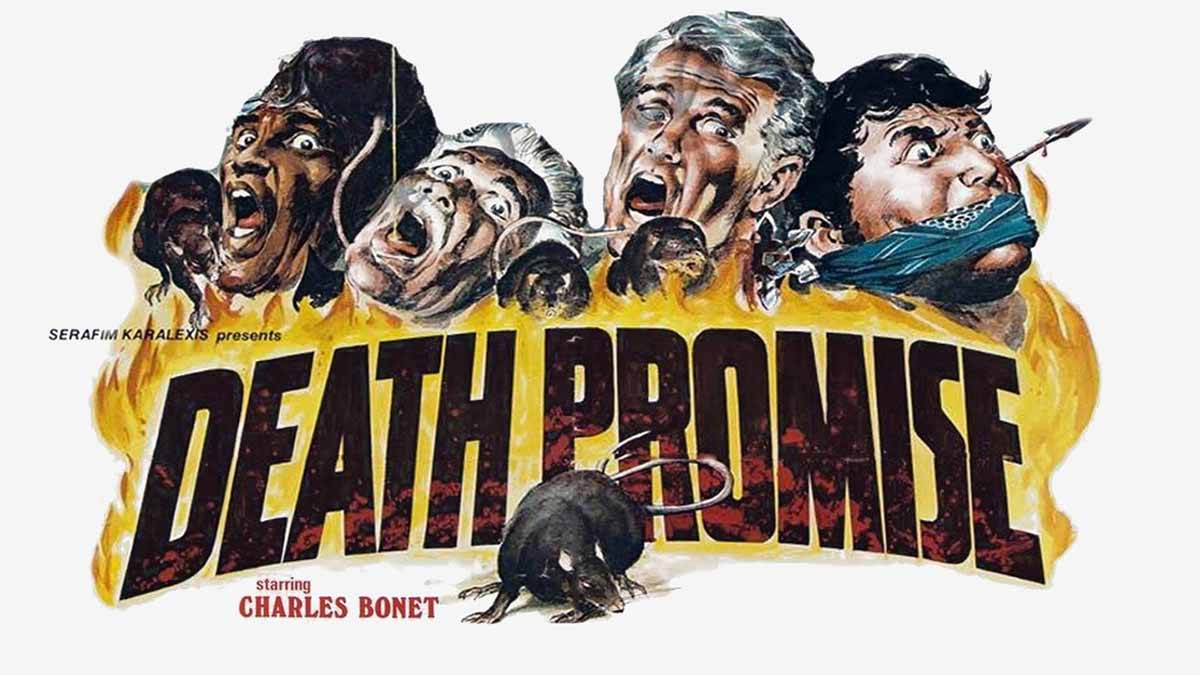
DEATH PROMISE (1977)
Dir: Robert Warmflash
Two late seventies films that never received a proper LA release crept into Los Angeles in 1980 as part of the Howard Mahler catalog, a South Bronx-set Kung Fu revengeamatic, and a third-rate Pam Grier rip-off, titled respectively, Death Promise and Velvet Smooth.
Velvet Smooth could be called Burlap Brown, that by comparison at least, makes Jack Hill look like Joseph Von Sternberg. The film features as its lead Johnnie Hill, a pretty worn out looking bag of bones, who is a practitioner of the lousiest Karate chops this side of Emma Peel. Star-power is left up to a cameo by the NY Jets’ Emerson Boozer, who gives Vida Blue in Black Gunn a run for his money when it comes to least auspicious screen debut.
The better film, Death Promise, is actually 1977’s The Slumlords, heavily promoted inside the pages of Marvel comics magazine The Deadly Hands of Kung Fu. Manhattan made Death Promise has the distinction of being a rare multiracial revengeamatic, Puerto Rican dude and Asian dude team up to fight greedy slumlords (including one token black slumlord). The entire project appears to be a starring vehicle for the films lead, Charles Bonet. Bonet isn’t particularly handsome, but he does have a distinct look, and while his acting experience is obviously limited, he’s good enough to lead this movie (he also goes through a large portion of the film wearing one of those one-piece Italian leisure suits made famous on Freaks and Geeks).
Bonet teams up with Asian Kung Fu sparring partner Bill (Sonny Chiba’s The Bodyguard) Louie to avenge the death of Bonet’s pop after he and they take on the vicious slumlords (the film’s original title) that are trying to evict them and the other tenants.
Normally this type of story falls on deaf ears with me.
The place is a fucking dump. Move out!
But the emphasis of the slumlord aspect, does offer the villains a deliciously detestable veneer. Especially, when in an effort to chase out the tenants, they drop off a box of rats in the hallway (talk about bastards, from that point on Bonet and Louie were justified for everything they did to those bastards). Naturally, the evil greedy slumlords, are trying to chase out the tenants in order to close on a big construction deal.
Like Alain Delon does to the mafia dons in No Way Out, and Dr. Phibes does to the doctors in his vendetta, Bonet and Louie individually take out the no name special guest stars playing the gargoyle slumlords. One lawyer is punched to death by a karate fist thrust through a car window, there’s a poison death ala-You Only Live Twice, and one unfortunate brother gets a bag of hungry rats tied to his face (ala-bag of snakes in Johnny Firecloud). And the main slumlord is variously pierced and sliced. And (surprise!) the main hit man working for the big bad slumlord is none other than the local martial arts instructor/mentor, who gets cut up and tossed off the building to his death.
Director Robert Warmflash keeps the fight blocking convincing in this ‘77 martial arts entry (Bonet could have joined the team in Force Five, he’s at least preferable to that Kill or Be Killed South African goon James Ryan). Norbert Albertson Jr.’s screenplay (which includes opening narration) barely qualifies as a story. But the Manhattan location photography of this era of New York in the seventies can’t be beat. A New York exploitation movie shot by New Yorkers for other New Yorkers has the feeling of a legitimate piece of regional cinema. Really only same era all male porn has this kind of New York authenticity. A lousy rock group named Opus, under the direction of composers Mike Felder and Bill Daniels, sing the lousy opening credit song. Nevertheless, the whole tenement slumlord angle sticks in the mind and offers the flick a unique backdrop. (C).
– Quentin Tarantino and Jim Sheldon –
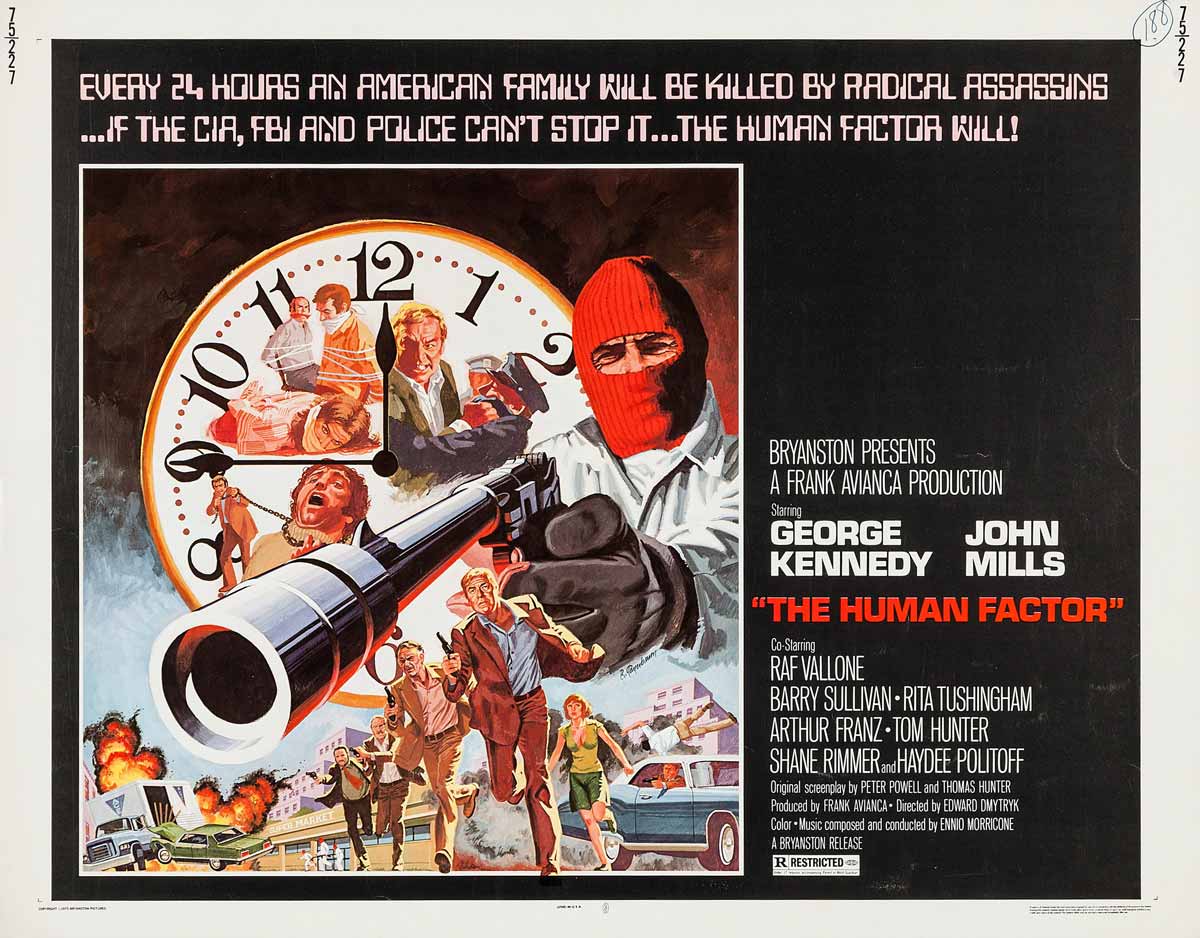
The ‘HUMAN’ FACTOR (1975)
Dir: EDWARD DMYTRYK
George (“Airport 75”) Kennedy plays John Kinsdale, an American computer engineer who lives abroad in Rome with his family (his wife and seven-year-old daughter), who becomes unglued when his loved ones are massacred one afternoon by a bunch of seventies Euro-styled, Baader-Meinhof inspired terrorists.
Soon it becomes apparent that these massacres of American families living abroad in Italy are part of a calculated rein of terror. The local Italian cop on the case, Raf (“The Other Side of Midnight”) Vallone, is sympathetic, but useless. So Kennedy’s Kinsdale turns to his fellow expatriate work buddy, British John (“Ryan’s Daughter”) Mills, and the two of them feed the information about the attacks into the brain of the super computer they work with (they work for a company, that through their computer, simulates war games for the American military). And lo and behold the computer discovers a pattern that the authorities are unaware of, and gives Kennedy an estimate on the next American family to be targeted by the terrorists. But rather than bring the ineffectual Italian police into the loop, George Kennedy, loaded for bear, goes by himself to do battle with the slaughterers of his family.
I didn’t see “Death Wish” when it was first released in ‘74 (when you’re dependent on your parents taking you to R–rated titles, some flicks get past you). It wasn’t till around ‘76, when “Death Wish” aired on The CBS Friday Night Movie that I finally saw it (the rape scene was scissored, but the rest held up rather nicely). So that makes Edward Dmytryk’s 1975’s “The ‘Human’ Factor” the first official ‘Revengeamatic’ I ever saw. I watched it with my mom and a few of her friends at a discount cinema in Hermosa Beach called The Marina 3, and a lusting for blood good time was had by all.
Before this movie I had seen films that had revenge as a motivation for their plot (“For A Few Dollars More”, “Hang ‘em High”, “The Abominable Dr.Phibes”), but they weren’t blood-thirsty revenge thrillers, where the propulsive engine for the entire film was sending its hero after the dirty inhuman killers who slaughtered their family and their vengeance-fueled hero wiping them out in a bombastic explosion of carnage at the pictures climax.
Burt Reynolds Gator McKlusky went after the sheriff J.C. Connors (Ned Beatty) for murdering his hippy kid brother Donny in “White Lightning”. But Reynolds doesn’t just go after the villains like a junkyard dog. He was calculating about his vengeance, he makes a deal with the Feds to try and get evidence of Connors’ bootlegging actives.
After the crooked casino, ‘The Lucky Spot’, slices him to ribbons and dumps him for dead on the side of the road, Joe Don Baker’s Buford Pusser gets his big stick and goes back to The Lucky Spot and busts a ton of skulls, shoulders, wrists, and arms. And that was absolutely a stand up and cheer audience moment.
But after that, “Walking Tall” still had an hour of movie left to go.
What was different about “The ‘Human’ Factor” was the roaring rampage of revenge was the whole enchilada. There wasn’t any question in the movie or its makers mind whose side the audience should be on.
And offering up this purifying slaughter of the wicked as the picture’s climax – a climax the whole movie has been dramatically building towards – was tremendously exciting.
My memory of the entire action set piece – which takes place in a supermarket where the terrorists are holding about thirty people hostage – is still vivid to this day.
Because I had never witnessed the bloodlust of the lead character pass over into the audience like it did in the final act of “The ‘Human’ Factor”.
It was one of the most thrilling and vivid connections I had ever felt between myself, the lead character on screen, and the strangers in the audience that surrounded me. We were all plugged into Kennedy’s retribution, and we all cheered in bloody unison as he blasted the bastards (especially the pretty-faced female terrorist, who acted as a decoy to all the slaughtered families).
That’s what I felt then, but how about now?
Actually, Edward (“Bluebeard”) Dmytryk’s “The ‘Human’ Factor” is one of those films that looks a hell of a lot more impressive today then it probably did when it came out. It’s really a well- made action film (it was Dmytryk’s last picture, and it’s one of the best last films of a decades spanning Hollywood journeyman).
At one point when Kennedy tracks down one of the terrorists and kills him, the scene becomes a little ridiculous (he ends up killing him with a chain like a Shaw Brothers movie). But even that sequence doesn’t derail the picture, it actually brings in a bit of levity that’s much appreciated. But after the terrorists chain death, Kennedy goes and investigates the house he found him at, and we get sucked right back into the seriousness of his vengeance quest, when we realize he’s found the terrorists hiding place. We recognize the rooms from a few glimpses we’ve been given in earlier scenes, and we’re impressed Big George has done such a good job tracking them down.
I also remember at that Marina 3 screening with my mom, The ‘Human’ Factor playing on a double feature with a George Segal movie called “Russian Roulette”, which was one of the most boring so-called action movies I had ever seen. But no worries, when it came to satisfying the audience, “The ‘Human’ Factor” did the work of two movies. Especially that squib blasting shoot ‘em up in the supermarket (when a housewife grabs a sub-machine gun and lends Kennedy a hand by blowing the shit out of one of the ski mask wearing terrorists, the audience lost their fucking minds!). And when the film ended on a Freeze-Frame of big George after he emptied his automatic into the terrorist cell leaders dead body, a collective ‘right on’ could be heard throughout The Marina 3 auditorium.
By virtue of it being my first Revengeamatic, a higher than deserved (B).
– Quentin Tarantino –
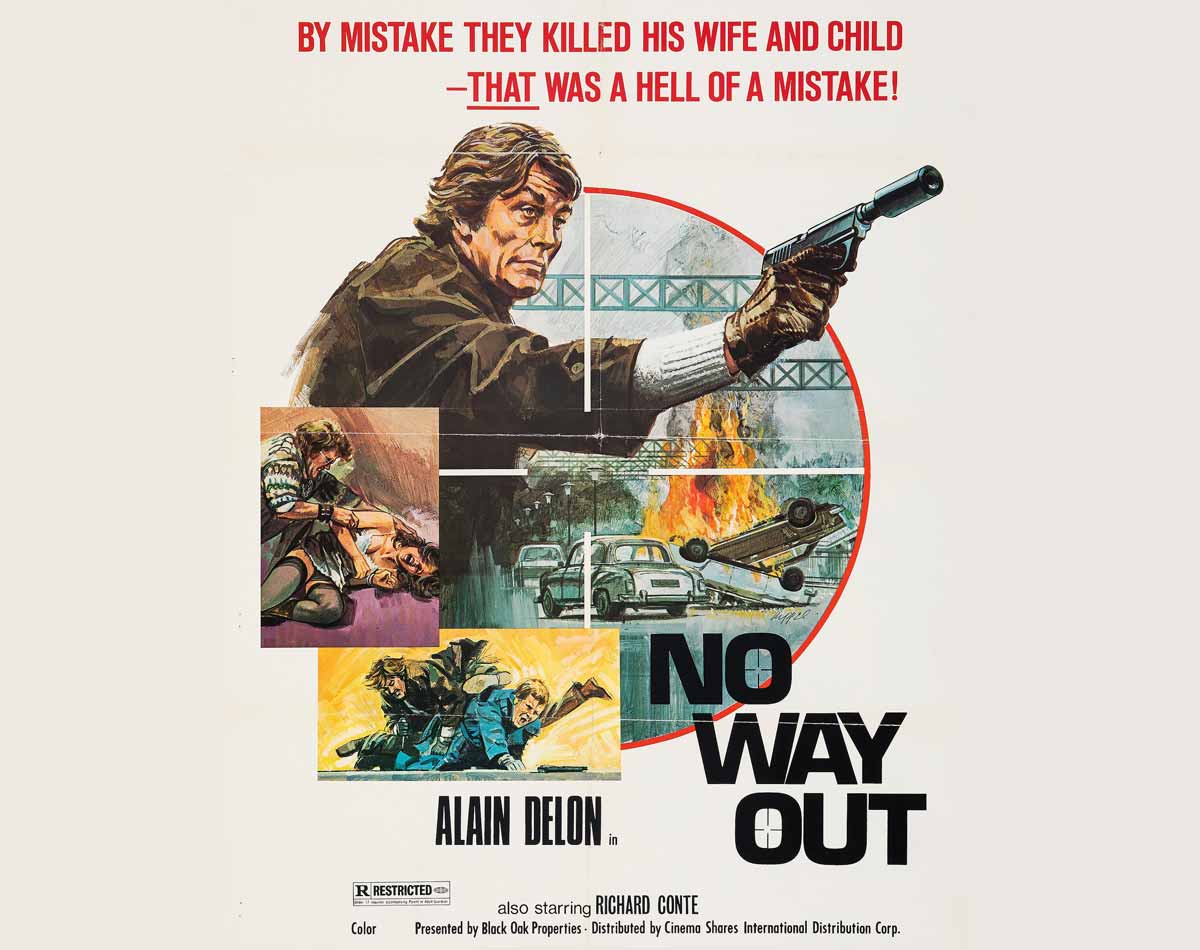
No Way Out (1975)
Dir: Duccio Tessari
A pasta-land violent crime picture where visiting French superstar Alain Delon blasts his way through an assortment of famous Euro film faces.
Tony Arzenta (Alain Delon) – the best Hit Man in the business – works for a crime family syndicate, run by four crime bosses, all from different countries, – legendary Hollywood old fuck – Richard (“The Violent Professionals”) Conte (Italy), eagle-faced – normally a Nazi – Anton Diffring (Germany, and also in Delon’s “Borsalino and Co”, and strangely unbilled here), Ettore (“Ringo and his Golden Pistol”) Manni (United Kingdom, and it’s implied he’s gay), and ugly American Lino (“Gambling City”) Troisi (USA, and in a group that includes Richard Conte and Anton Diffring, he’s the asshole!), and their lawyer oily-haired Umberto(“The Family”) Orsini. When Delon’s Arzenta informs the four crime bosses he wants to retire, they retaliate by accidentally blowing his wife Nicoletta (“Navajo Joe”) Machiavelli and their effeminate young son to smithereens (You don’t quit us, we retire you, permanently!). So naturally the greatest Hit Man in the business, makes it his business to rub out all four capo’s in big Omen-style murder set pieces, Manni on a train (my favorite), Diffring and his body guards on the streets of Copenhagen, Troisi at his home (with his wife Rosalba Neri, who maybe has thirty seconds of screen time), and finally at the end with Conte and Orsini in a cynical surprise freeze frame finish (Surprise? I saw it coming a mile away). As effective as Delon is in his made-to-order top of the heap hit man role, it’s the guest-star mob bosses waiting their turn to be bumped off in grand Roman style, that fuels the fun of the film. They bring to mind the special guest-star victims of “The Abominable Dr. Phibes” – in fact you keep waiting for Terry Thomas to show up and get his brains splattered against the wall by Delon’s Arzenta.
Despite being a particularly vicious entry in an already violently vicious genre, “No Way Out” is a pretty classy affair. The film hums at a hurtling pace (as soon as it gets going i.e. wifey and brat go boom!), and Tessari has a real commitment to staging the action scenes as brutal and operatic as possible, keeping viewers interest throughout (like for instance the huge fish tank in one of the bosses house. You know it’s going to play into the eventual murder set piece, but when it finally does it’s even more spectacular than you were expecting).
And you just can’t underestimate the effect that visiting (slumming?) French superstar Alain Delon has on this whole enterprise. There’s a superstar royalty excitement to Alain Delon’s presence in this film that the violent Henry Silva Italian trash movies don’t possess. The dark haired Delon has appeared in some pretty classy crime movies and the after effects of Henri Verneuil, Jean Herman, and René Clément are immediately felt as soon as Delon’s Tony Arzenta enters frame, but especially Jean-Pierre Melville, and particularly the two men’s most stylish collaboration, “Le Samurai”.
Now admittedly, any movie that cast Alain Delon as – the best Hit Man in the business – is going to bring to mind Jef in the Melville film. But Tessari leans into the connection, not away from it. As much as the three Sergio’s (Leone, Corbucci, and Sollima), it was Tessari with his two Ringo movies (“A Pistol For Ringo” and “The Return of Ringo”) that popularized the Italian western genre in the beginning. But after a few years, with a couple of exceptions (his genuinely mysterious giallo “My Dear Killer”), he drifted into the loud, highly acrobatic, comic style action film that was popular in Italy in the seventies, and most of these entires are of no interest whatsoever.
But getting the gig directing Alain Delon, in his first (and only) Italian crime picture, brings the best out of the filmmaker (no lazy zooms, no forever fiddling with the focus before the camera assistant finally finds it, no sloppy post-sync flubs, and unlike a lot of pasta-land pictures, a real attempt at sound editing). And that’s partly due to Delon’s presence, Tessari’s larger then normal budget, and longer than normal shooting schedule, and his effective mimicry of J.P. Melville.
“No Way Out” doesn’t play like an Italian crime picture done in the style of J.P. Melville. It plays as if Jean-Pierre Melville came to Italy in ‘74 and made a violent Hit Man movie with his boy Delon. In fact if you want to view the whole film as a de facto sequel to “Le Samurai”, go ahead.
A richly deserved (B+).
– Quentin Tarantino –
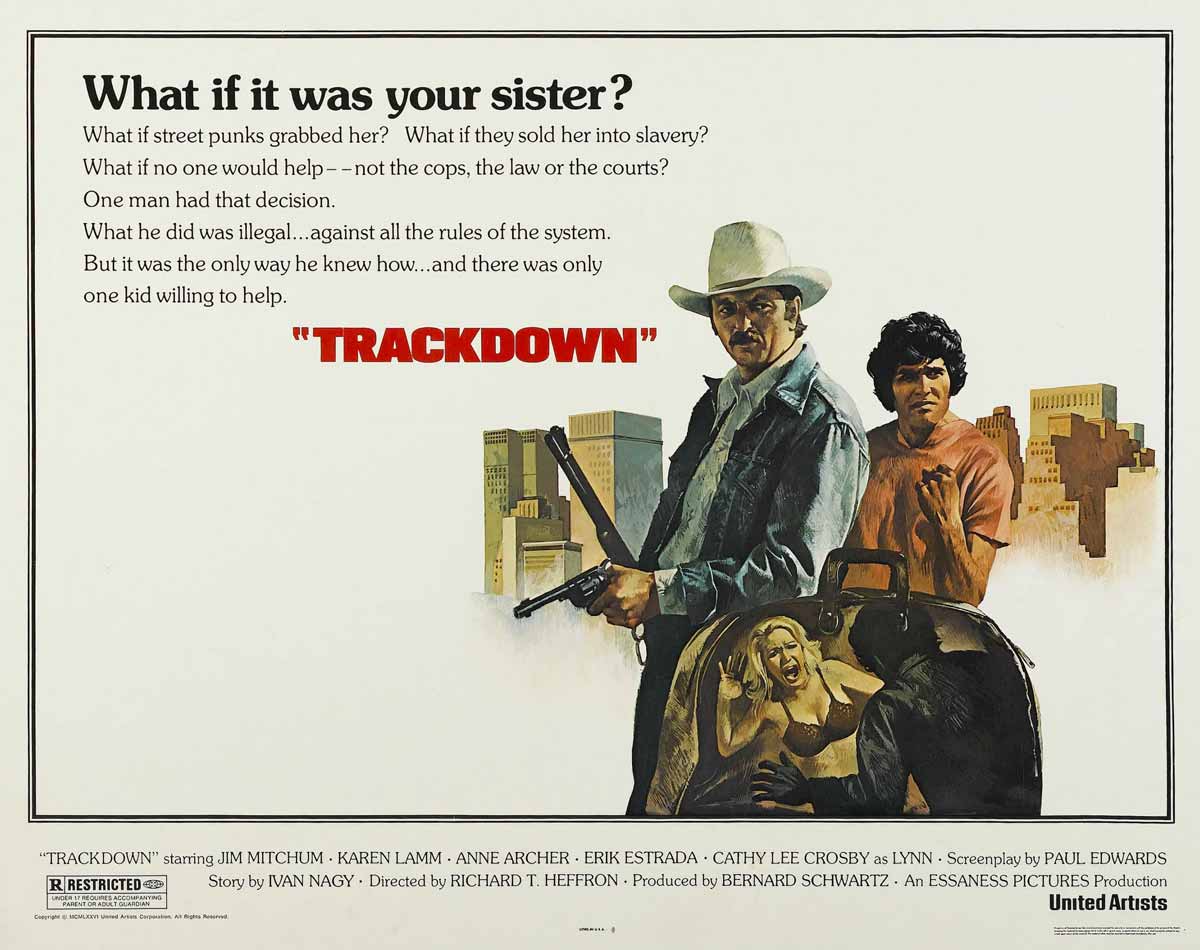
TRACKDOWN (1976)
Dir: Richard Heffron
If after I describe the plot of Richard Heffron’s “Trackdown” it sounds familiar, that’s because it’s a cross-between both of Paul Schrader’s screenplays, “Taxi Driver” and “Hardcore”.
Pretty teenage runaway Betsy Calhoun, played by pretty Karen (“Almost Summer”) Lamm (before she became Mrs. Dennis Wilson), gets targeted within minutes of stepping off the bus from Wyoming onto Hollywood Blvd. Pimps that staked out the Hollywood bus terminal and went shopping for young naive underage white girls as easily as they’d shop for cantaloupes in the fruit section of the supermarket was a cliche in most movies of this ilk (see also “Little Ladies of the Night” and “Kinjite”).
Once in Hollywood her bag with all her possessions and money is stolen, leaving her desperate and helpless, all the better for Hollywood con man Chucho (played by Erik Estrada, before Ponch on “CHiP’s, but after Julio in “Airport 1975”) to swoop in and save the day (Estrada arranged for her bag to be stolen). And soon he buys her some food, wins her confidence, and they go to his apartment where he seduces her. But a carload of Latino lowrider stereotypes show up and snatch Betsy from Chucho (who reluctantly hands her over to the vicious vatos). The gang-bangers gang-bang Betsy, then string her out on heroin, then sell her to frizzy frantic Ray Sharkey (two years before “Who’ll Stop the Rain”) who hops up and down and lets his feather-like mustache give his performance for him. Sharkey then sells Betsy to a high-priced prostitution racket owned by snarling one-note Vince Cannon (sort of a bantam weight James Lusi), and run by his classy madam Jessica (played by a slumming Anne Archer), who cleans Betsy up, buys her some nice dresses, and takes her under her wing in the high-priced call girl game (Archer is sort of like Norma, the madam that Nancy Allen’s Liz Blake is always on the phone with in “Dressed To Kill”, only three years down the line).
Meanwhile, a big ass pickup truck pulls into town driven by Wyoming horse rancher Big Jim Calhoun, played by Robert Mitchum’s son, Big Jim Mitchum (in easily his best leading man performance). Betsy is his sister, he knows she’s runaway to Los Angeles, and he’s come to find her and take her back home. At first he’s given the runaround by the police and the halfway houses, till he befriends a sympathetic social worker played by “The Dark’s” Cathy Lee Crosby (sporting a stunning Farrah Fawcett flip), and unconvincingly a guilty Erik Estrada who wants to make amends.
For an initial viewing the film’s an enjoyable revengeamatic.
It has a strong cast, and as per usual Richard Heffron does a good job telling the story (he was one of the main directors on George Peppard’s TV series “Banacek”, where storytelling was everything), and personable Karen Lamm’s road to ruin sticks in your guts. Compared to all these movies (“Taxi Driver”, “Hardcore”, “Little Ladies of the Night”, “Angel” ) it’s Lamm’s Betsy that I’m the most invested in being saved (the film’s cruelest touch is killing Lamm before Mitchum finds her).
But on a second viewing it just doesn’t have enough standout scenes to go with the movie’s – admittedly entertaining – attitude.
Once Betsy bites the dust, it’s hard to justify getting to the closing credits. Other than poor Karen Lamm’s journey, and Jim Mitchum’s genuine likability, the only thing anybody remembers about “Trackdown” is its one really clever action scene.
High class whoremonger Vince Cannon runs his nooky enterprise in the penthouse of a tall building (not quite a skyscraper, but close). Mitchum and his side-kick Estrada (I never forgive Estrada for the part he played in Lamm’s tragedy the way Mitchum seems to) try to gain access to Cannon’s lair by coming up the elevator shaft. With Estrada bringing their elevator car up and down and Mitchum blasting away with his 45 Automatic on the roof at Cannon’s bodyguards in their supersonic private express elevator. It’s a real nifty scene that’s very impressively staged with Mitchum never looking better.
During the elevator shaft scene, the film finally gets to where you’ve hoped its been going all along. Unfortunately that’s as good as the films ever going to get, and it’s never going to get that good again. The film needed at least three scenes like that.
But minus that, the effort just comes across like violent television.
Columbia Pictures opened “Taxi Driver” in February of ‘76. Three months into its run, in April of ‘76, United Artists (rather cheekily) opened “Trackdown”. Now it wasn’t unusual for a rival studio to pick up a cheapie exploitation picture as an independent pick up that resembles a classier film by one of their competitors. But usually they’d wait till after the original film had finished its theatrical engagement. In April “Taxi Driver” was still playing in cinemas, in fact it was just starting to widen its opening to neighborhood cinemas.
So that was a clear case of United Artist kicking Columbia in the shins with not just a cheapie knock-off, but the type of film that Paul Schrader’s screenplay was meant to subvert.
“Trackdown” is “Taxi Driver” without irony.
Without question.
“Trackdown” is an unexamined “Taxi Driver”. (C+)
– Quentin Tarantino –
